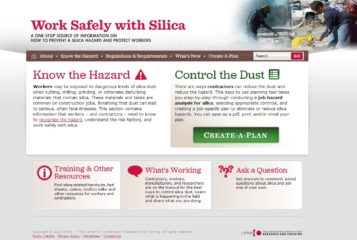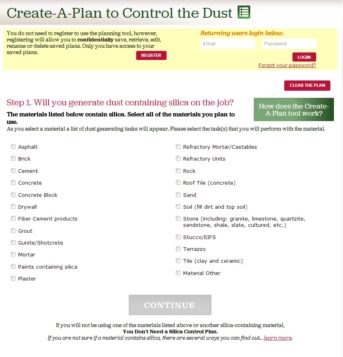
Creating a plan to work safely with silica
Even before OSHA’s proposed silica standard was in the news, contractors ahead of the curve were looking for information about the hazard and control methods.
To make it easier to find what they need, CPWR — The Center for Construction Research and Training, solicited input from contractors and other stakeholders to develop the Work Safely with Silica website (www.silica-safe.org). This resource includes training materials, examples of “what’s working” in the field, research findings, news articles, a history and the latest information on regulatory efforts and responses to frequently asked questions.
But that’s not all. A central feature of the site is a free, online planning tool, “Create-A-Plan,” which enables contractors to identify silica hazards, find available control methods and develop a site-specific silica control plan in three steps.
Step 1 asks: Will you generate dust containing silica on the job?
You will be prompted with lists of common building materials that contain silica and dust-generating tasks. You can select as many combinations of materials and tasks as you anticipate on your job. If unsure of whether or not a material contains silica, this step offers four ways to find out, including how to find the information on a safety data sheet and how to have a sample of the material tested.
Step 2 asks: How do you plan to control the dust?
In this step, a list of equipment and control options for each of the material/task combinations you selected in Step 1 is generated. You will be able to select more than one type of equipment-control for each material, and for each there is an option to “Click here for examples of commercially available equipment and controls.” The examples typically include manufacturer information, videos and impartial third-party information. You can also manually enter equipment-controls of your own, and there is space to describe how you plan to use the material(s), equipment and controls on the job. If you are not sure which control is best, this step provides access to published research, information on how to find someone to perform air monitoring and access to OSHA’s free, confidential On-site Consultation Program.
Step 3: Complete your plan
In this step, fill in the remaining elements of a comprehensive silica control plan. There is space for your company name, jobsite and work description, the competent person, training that workers will receive on the hazard and controls, steps to protect bystanders and other actions you plan to take to work safely. For each element, there is a “learn more” option with additional information to consider including in your plan. You do not need to complete every field in Step 3 to generate a final plan, and at each step you can easily go back and make changes.
When complete, click “continue” to generate your plan. In addition to being able to print, email or save a plan as a PDF, a new feature, added at the request of users, allows you to set up a confidential, password-protected account where plans can be saved, retrieved, modified and re-saved with new file names for use on future jobs. As an added benefit, plans can be used as site-specific tool box talks.
Work Safely with Silica is continuously being updated with new information, controls and research findings. For more information, email silica@cpwr.com.
Editor’s Note: Research and information for this article was prepared by CPWR — The Center for Construction Research and Training. For more information, visit www.cpwr.com.




 Join our thriving community of 70,000+ superintendents and trade professionals on LinkedIn!
Join our thriving community of 70,000+ superintendents and trade professionals on LinkedIn! Search our job board for your next opportunity, or post an opening within your company.
Search our job board for your next opportunity, or post an opening within your company. Subscribe to our monthly
Construction Superintendent eNewsletter and stay current.
Subscribe to our monthly
Construction Superintendent eNewsletter and stay current.